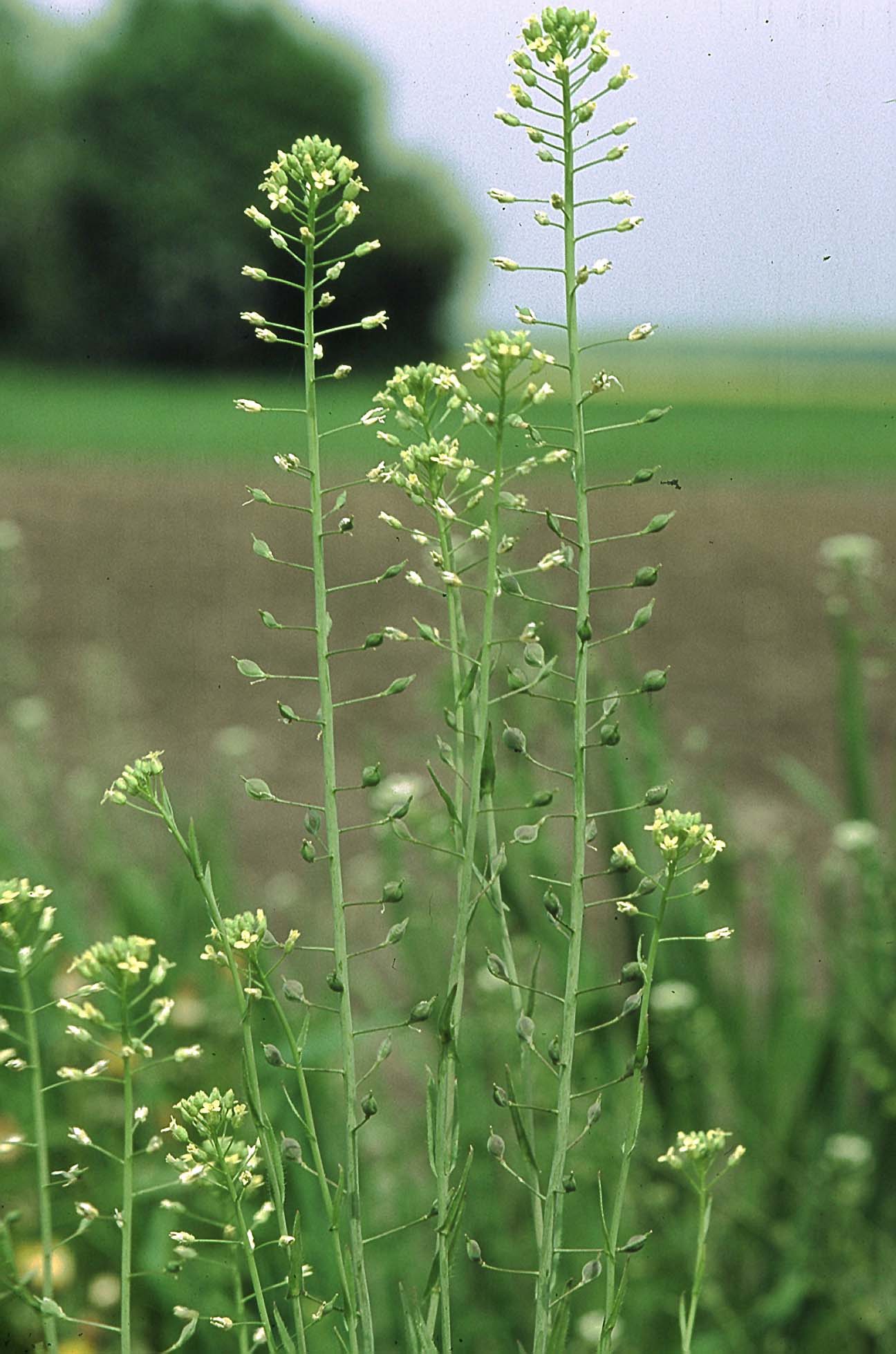- Camelina sativa
taxobox
name = Camelina
regnum =Plantae
unranked_divisio =Angiosperms
unranked_classis =Eudicots
unranked_ordo =Rosids
ordo =Brassicales
familia =Brassicaceae
genus = "Camelina "
species = "C. sativa"
binomial = "Camelina sativa"
binomial_authority = L. Crantz|"Camelina sativa", usually known in English as gold-of-pleasure or false flax, also occasionally wild flax, linseed dodder, camelina, German sesame, and Siberian oilseed, is a
flowering plant in the familyBrassicaceae which includes mustard,cabbage ,rapeseed ,broccoli ,cauliflower ,kale ,brussels sprouts . It is native toNorthern Europe and toCentral Asia n areas, but has been introduced toNorth America , possibly as aweed inflax .It has been traditionally cultivated as an
oilseed crop to producevegetable oil andanimal feed . There is ample archeological evidence to show it has been grown inEurope for at least 3,000 years. The earliest findsites include theNeolithic levels atAuvernier ,Switzerland (dated to thesecond millennium BC ), theChalcolithic level atPefkakia inGreece (dated to thethird millennium BC ), andSucidava-Celei ,Romania ("circa" 2200 BC).Daniel Zohary and Maria Hopf, "Domestication of plants in the Old World", third edition (Oxford: University Press, 2000), pp. 138f] During theBronze age andIron age it was an important agricultural crop in northern Greece beyond the current range of theolive . [Harvard citation|Jones|Valamoti|2005|p=575] [Harvard citation|Megaloudi|2006|p=57] It apparently continued to be grown at the time of theRoman Empire , although its Greek and Latin names are not known. [Harvard citation|Dalby|2003|p=161] According to Zohary and Hopf, until the 1940s "C. sativa" was an important oil crop in eastern and central Europe, and currently has continued to be cultivated in a few parts of Europe for its seed which was used, for example, inoil lamps (until the modern harnessing of natural andpropane andelectricity ) and as an edible oil.The crop is now being researched due to its exceptionally high levels (up to 45%) of
omega-3 fatty acid s, which is uncommon in vegetable sources. Over 50% of the fatty acids incold pressed Camelina oil arepolyunsaturated . The major components arealpha-linolenic acid - C18:3 (omega-3-fatty acid, approx 35-45%) andlinoleic acid - C18:2 (omega-6 fatty acid, approx 15-20%). The oil is also very rich in naturalantioxidants , such astocopherol s, making this highlystable oil very resistant tooxidation andrancidity . It has 1 - 3% erucic acid. Thevitamin E content of camelina oil is approximately 110mg/100g. It is well suited for use as acooking oil . It has analmond -likeflavor andaroma . It may become more commonly known and become an important food oil for the future.Because of its certain apparent health benefits and its technical stability gold-of-pleasure and camelina oil are being added to the growing list of foods considered as
functional foods . Gold-of-pleasure is also of interest for its very low requirements fortillage and weed control. This could potentially allowvegetable oil to be produced more cheaply than from traditional oil crops, which would be particularly attractive tobiodiesel producers looking for a feedstock cheap enough to allow them to compete withpetroleum diesel and gasoline. [http://www.camelinacompany.com Great Plains - The Camelina Company] began research efforts with camelina over 10 years ago. They are currently contracting with growers throughout the U.S. and Canada to grow camelina for biodiesel production. A company in Seattle, Targeted Growth, is also developing camelina. [Harvard citation|Seattle Times|, November 21, 2007|page=C1]The subspecies "C. sativa" subsp. "linicola" is considered a
weed inflax fields. In fact, attempts to separate its seed from flax seeds with a winnowing machine over the years have selected for seeds which are similar in size to flax seeds, an example ofVavilovian mimicry .Notes
References
*Harvard reference | Surname=Dalby | Given=Andrew | Authorlink=Andrew Dalby | Title=Food in the ancient world from A to Z | Publisher=Routledge | Place=London, New York | Year=2003 | ISBN=0415232597
*Citation | doi = 10.1007/s00334-005-0004-z | last1 = Jones | first1 = G. | last2 = Valamoti | first2 = S.M. | year = 2005 | title = Lallemantia, an imported or introduced oil plant in Bronze Age northern Greece | journal = Vegetation History and Archaeobotany | volume = 14 | issue = 4 | pages = 571-577
*Harvard reference | Surname=Megaloudi | Given=Fragkiska | Title=Plants and Diet in Greece from Neolithic to Classic Periods: the archaeobotanical remains | Publisher=Archaeopress | Place=Oxford | Year=2006 | ISBN=1841719498
*D.H. Putnam, J.T. Budin, L.A. Field, and W.M. Breene (1993) " [http://www.hort.purdue.edu/newcrop/proceedings1993/v2-314.html Camelina: A Promising Low-Input Oilseed] ". p. 314-322. In: J. Janick and J.E. Simon (eds.), New crops. Wiley, New York.
*Harvard reference | Surname=Seattle Times (Angel Gonzalez) | Authorlink=Angel Gonzalez | Title=Seeding the way to better biofuels | Place=Seattle, WA, USA | Year=November 21, 2007External links
* [http://plants.usda.gov/java/profile?symbol=CASA2 PLANTS Profile: Camelina sativa (L.) Crantz]
* [http://dx.doi.org/10.1016/j.indcrop.2003.12.004 "Evaluation of Camelina sativa oil as a feedstock for biodiesel production", " Industrial Crops and Products", Vol. 21 Issue 1 (January 2005), pp. 25-31]
* [http://www.camelinacompany.com Great Plains - The Camelina Company]
Wikimedia Foundation. 2010.
